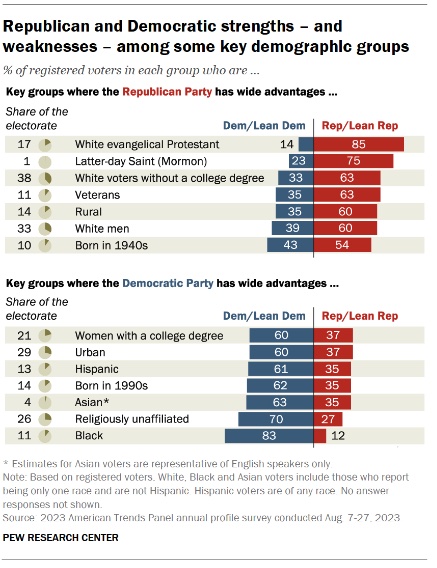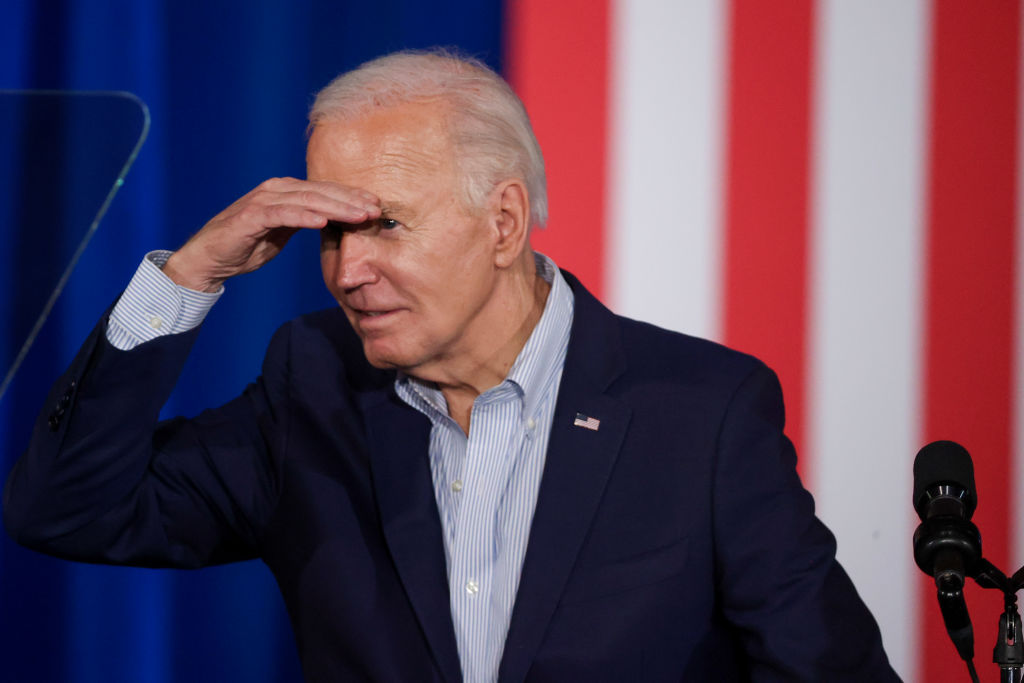There are a couple of good questions to ask about the political ramifications this year of the overturning of Roe v. Wade in June 2022 and subsequent state-level efforts to expand or restrict access to elective abortions.
How much does the issue persuade voters and how much does it motivate voters?
For the first one, we want to know how many people who were already likely voters are being moved, in at least substantial part, by the issue to choose a different candidate. This one is tricky, because authentic “single issue” voters are rare. And if one is so intently focused on abortion, it seems unlikely that he or she was a persuadable voter to begin with.
What we’re really looking for are people who usually vote and typically have a partisan preference or are true toss-ups, but found abortion to be a tipping point to move them one way or another.
And we don’t particularly care about voters’ own rationalizations to pollsters about their own choices in exit polls. That’s pretty spongy stuff. If you ask someone who just bought a Ford instead of a Chevy why they made the choice, they’re liable to be invested in defending what they did rather than providing clear-eyed analysis.
So let's start with a good baseline: American attitudes about elective abortion over recent history.
Three decades ago, there was a broad pro-choice consensus among American voters. But around the turn of the century, things shifted. Data from the Pew Research Center show that the combined share of American adults who thought abortion should be legal either in all or most instances dropped 10 points between the years 1995 and 2010, sliding from 60 percent to 50 percent.
But in the following decade, support for legal abortion rebounded: On the eve of the fall of Roe in 2022, the share of pro-choice Americans was 61 percent.
We could debate the reasons—damage to the pro-life brand from Donald Trump, the sharp left turn of younger voters, a cascade of attempted state-level restrictions that followed Republican gains of the Obama era, and anxieties about the fall of Roe as the composition of the Supreme Court changed. All are probably true, all are complementary, and none are themselves sufficient. But whatever the combination of reasons, the trend was unmistakable.
Also unmistakable is the demographic tilt in the data. Pew found the least pro-choice constituency to be older, whiter, and more male than the electorate as a whole. The most pro-choice constituencies are younger, female, and from minority populations.
America got a lot more pro-choice from 2010 to 2022, and the trend only intensified post-Dobbs.
That’s a lot of evidence on the persuasion front. America obviously moved left on abortion, which is helpful to a Democratic Party that has made access to abortion a key part of its pitch for five decades. But did it really move votes? Attitudes about lots of issues shift without ultimately shifting partisan or candidate preferences.
Let’s look at Arizona, which is now the hottest spot in the abortion debate after justices on the state Supreme Court ruled that a 19th-century ban that had been blocked by Roe was now enforceable. Pro-choice activists had already been preparing a referendum for the November ballot. Given the long list of referendum victories for pro-choicers, this is ominous news for Republican hopes in one of the states most vital to the party’s chances this fall.
But that’s an argument for how abortion may motivate rather than persuade. We will get to that, but we first need to answer the question about the effect of abortion as an issue on the electorate as it exists, before we consider how many new or low-propensity voters might come in to change the landscape. And Arizona offers a prime example.
In 2018, a very good year for Democrats, the blue team picked up a Senate seat in the Grand Canyon State when Kyrsten Sinema defeated Martha McSally by about 2 points. According to data from the Associated Press’ VoteCast survey, 65 percent that year said abortion should be legal either in all or most cases. Not surprisingly, Sinema won those voters by a whopping 23 points.
But while the nation as a whole was getting more pro-choice in the intervening years, not so for the Arizona electorate. The VoteCast numbers for the presidential election of 2020 show the pro-choice share of the electorate actually ticked down 2 points to 63 percent.
The funny thing is that Joe Biden did even better with this slightly smaller group than Sinema had done two years prior. He won these voters by 31 points, 8 points better than the Democrat’s margin in the previous midterm. But maybe the two electorates are just so different that it doesn’t tell us much. Quadrennial turnout is so much higher than in midterms.
But check out what happened in 2022: Turnout was lower than the presidential and even a smidge lower than it had been in 2018. Also down was the share of the electorate identifying itself as pro-choice, declining another 2 points to 61 percent. A smaller electorate that was more pro-life ought to be good for Republicans. But it was the opposite.
Democratic Sen. Mark Kelly, who had won a special election in 2020 for the seat formerly held by John McCain, was up for election to a full term in 2022. He defeated Republican nominee Blake Masters by nearly 5 points, double Kelly’s margin two years prior. We could explain this in many ways, including incumbency, Masters’ deficiencies as a candidate, etc.
But there’s also this: Kelly won among pro-choice voters by 52 percent, 21 points better than Biden with this group and 29 points better than Sinema four years earlier. The electorate overall had gotten less pro-choice and the share of young voters and young women in particular had either stayed the same or declined over those four years.
That gives us very strong evidence that the issue became more important to an electorate that looked in most regards the same. It persuaded rather than motivated.
We see the same thing in Pennsylvania in 2022, when Sen. John Fetterman won a hotly contested race against Republican Mehmet Oz. We don’t see the share of young women increasing from 2020 to 2022, holding basically steady from 19 percent in the presidential year to 18 percent in the midterm. But how they voted was very different. Biden won these voters by 15 points, Fetterman by 27 points. Looks like a lot of abortion as persuasion.
But we see motivation there, too. The share of the electorate that was pro-choice in Pennsylvania went from 60 percent in 2020 to 65 percent in 2022. Some of that could be people switching on the issue, but I suspect that we would find some low frequency voters and new voters who were brought out by the issue.
That certainly seems to be the case in Wisconsin, where the AP numbers show the pro-choice constituency climbing from 57 percent in 2018 to 60 percent in 2020 to 64 percent in 2022. And while some of it, again, is about voters changing their views, significant increases in the share of the electorate that was young and female points strongly toward the fall of Roe as motivator more than persuader.
We could also look at voter registration data after the fall of Roe. In North Carolina, which has one of the most transparent troves of voter-registration data, the results seem to be clear. According to a well-researched scholarly paper: “The odds of women registering to vote after June 17, 2022, were 3.8 percent higher than others, controlling for all other variables. This effect was highly significant.”
This jibes with the national trend in the immediate aftermath of the ruling. Tufts University researchers found that for voters under 30, new registrants were substantially more female than male and that overall levels of registration for young voters was up significantly in many states.
That’s all a long way of saying that it’s not either persuasion or motivation, but that it is persuasion and motivation.
All the evidence, though, points to significant differences in the way the issue works state by state. North Carolina and Wisconsin tell us the story of the issue motivating lower-propensity voters to get in the game while Pennsylvania and Arizona data show us a basically static electorate driven toward the Democrats by the increasing focus on abortion.
And with Arizona likely to have a high-stakes ballot initiative on the subject in November and a scorched earth Senate campaign intensely focused on abortion, there’s a good chance that Democrats will benefit from both the participation of less-likely voters as well as the increased salience of the issue for the already likely voters.
And that points to a double-whammy of a problem for Republican hopes to flip back a must-win state in 2024.
Holy croakano! We welcome your feedback, so please email us with your tips, corrections, reactions, amplifications, etc. at STIREWALTISMS@THEDISPATCH.COM. If you’d like to be considered for publication, please include your real name and hometown. If you don’t want your comments to be made public, please specify.
STATSHOT
Biden Job Performance
Average approval: 39.8%
Average disapproval: 56.4%
Net score: -16.6 points
Change from one week ago: ↑ 0.2 points
Change from one month ago: ↑ 2.2 points
[Average includes: TIPP: 37% approve-52% disapprove; NPR/PBS/Marist: 44% approve-53% disapprove; Marquette: 40% approve-60% disapprove; Fox News: 41% approve-58% disapprove; Quinnipiac: 37% approve-59% disapprove]
Polling Roulette

TIME OUT: ‘THE HARDEST GEEZER’
Guardian: “After more than 9,940 miles over 352 days across 16 countries, Russ Cook, aka the ‘Hardest Geezer’, has completed the mammoth challenge of running the length of Africa. The 27-year-old endurance athlete from Worthing, West Sussex, crossed the finish line in Tunisia on Sunday afternoon, and planned to celebrate with a party – as well as a strawberry daiquiri – having raised more than [$746,000] for charity. His achievement, believed to be the first person to run tip to tip from southern to northern Africa, was the more extraordinary given several setbacks including a robbery at gunpoint in Angola, being held by men with machetes in Republic of the Congo, health scares and visa complications. … On 22 April 2023 he set off from South Africa’s most southerly point, Cape Agulhas. By the time he crossed the line at Tunisia’s most northerly point, Ras Angela, he had run the distance of about 376 marathons. … He finished to cheers of ‘Geezer, Geezer’ and took a well-deserved dip in the sea, telling Sky News: ‘I’m a little bit tired.’”
BIDEN RAISES $90 MILLION IN MARCH, OUTPACING TRUMP
AP: “[President Joe Biden’s reelection campaign and the DNC] raised more than $90 million in March and ended the year’s first quarter with $192 million-plus in cash on hand, further stretching their money advantage over Donald Trump and the Republicans. The Biden campaign and its affiliated entities reported collecting $187 million from January through March and said that 96% of all donations were less than $200. … The campaign said the $192 million-plus as of March 31 was the highest total ever by any Democratic candidate. … Trump campaign officials have said they do not expect to raise as much as the Democrats, but will have the money they need.”
Trump claims Palm Beach fundraiser pulls in $50 million: CBS News: “Former President Donald Trump's campaign said it raised $50.5 million at a Saturday event in Florida. … The record-breaking sum that the campaign reported raising at a Palm Beach, Florida fundraising dinner on Saturday far surpasses the amount brought in by a star-studded fundraiser for the Biden campaign last month, as the GOP touted the event as an indicator of party's unity behind the former president. … The Palm Beach, Florida dinner, which was held at the home of investor John Paulson, featured remarks from the former president, who highlighted the need to win back the White House. … The event also included remarks from North Dakota Gov. Doug Burgum and entrepreneur Vivek Ramaswamy, among others.”
GOP closed Nevada minority outreach centers after midterms: Nevada Independent: “In 2020 and 2022, the Republican National Committee (RNC) and Nevada GOP made a well-publicized push to attract voters of color by opening several minority outreach centers in the Las Vegas Valley. … ‘This is a long-term commitment the RNC is making to communities’ said then-RNC Chair Ronna McDaniel. … But a Nevada Independent analysis found that those four locations are closed. … The situation presents a dramatic split-screen from the Biden campaign, which, in recent weeks, has opened offices across the Las Vegas Valley as part of its effort to court minority voters in the Silver State. In March, the campaign opened offices in North Las Vegas and southeast Las Vegas, parts of the city with high Black and Asian American populations.”
While Pennsylvania Dems plead with Biden to look beyond Philly: New York Times: “President Biden loves Philadelphia. And he loves campaigning there, too. … Now, some Democrats are saying that it is time for Mr. Biden and his campaign to widen their reach across the Keystone State. … [Former Rep. Conor Lamb] urged Mr. Biden to spend more time in the state’s rural and rust-belt communities, which are predominantly home to white working-class voters but also have pockets of African American voters in former mill towns. ‘I think people in Philadelphia and Pittsburgh are reachable online and over TV in a way that voters in some of these smaller, older places might not be,’ he said. … The Biden campaign says that it is taking a robust, statewide approach, opening 14 offices across Pennsylvania last month, including in swing areas like Erie County. In contrast, Mr. Trump has yet to announce the opening of a single office in Pennsylvania.”
POLL: SHEEHY NARROWLY LEADS TESTER
Helena Independent Record: “The poll from J.L. Partners, provided exclusively to the Montana State News Bureau, shows Tim Sheehy leading Jon Tester within the margin of error, by 48% to 45% with 7% of those polled undecided. … Among independents, who could play a critical role in the race, Tester held 49% to Sheehy's 39%, with 11% undecided. … Those polled ranked inflation and the economy as the most important issue facing Montana, at 33%, followed by border security and illegal immigration at 20% and threats to democracy at 15%. Climate change, health care, abortion, national security, election integrity and crime and public safety all ranked in the single digits. … Undecided voters found inflation and the economy most important, followed by border security and illegal immigration.”
GOP drops $15 million to hit Tester on immigration: Politico: “One Nation, a group aligned with Senate GOP leadership, is beginning a $15.2 million ad buy on Friday which will run through the summer. The first ad, running statewide on TV and digital, goes after Tester’s past statements and votes on immigration, criticizing his positions on ‘amnesty,’ the border wall and sanctuary cities. … One Nation’s big reservation is a spring and summer bridge for Republicans to $48 million in reservations from GOP groups beginning in September. … Senate Majority PAC, a key Democratic group, reserved $27 million in ads in the state as well — signs that the race is likely to go well over $100 million.”
Vulnerable Dems feel the squeeze on Mayorkas impeachment: Politico: “Senate Republicans are trying to orchestrate the impeachment trial of Homeland Security Secretary Alejandro Mayorkas to exact maximum political pain on their top Democratic targets in November — especially Sens. Jon Tester and Sherrod Brown. … Democrats will need near-unanimity to dismiss [the impeachment articles]. That puts vulnerable Democrats like Tester (Mont.) and Brown (Ohio) in an unenviable bind, and some of their purple-state colleagues will also feel the heat. … As Tester has faced the GOP’s immigration attacks, he’s called on Democratic leaders to force Republicans to vote again on the bipartisan border deal. … Sen. Jacky Rosen (D-Nev.), another vulnerable incumbent, also did not commit to supporting a motion to dismiss this month. … Sen. Tammy Baldwin (D-Wis.) is expected to vote to shut down the trial.”
Gallego tries to shed progressive label: NBC News: “Democratic Rep. Ruben Gallego referred to himself as ‘a true progressive voice in Congress’ in a fundraising email in 2022. In 2018, he rallied alongside Sen. Bernie Sanders. … It’s not a label Gallego, who rose through the political ranks as a liberal firebrand, is embracing the same way now as he runs for Senate. … Last month, Gallego allowed his membership in the Congressional Progressive Caucus to lapse, … He’s trying to jump from a congressional district President Joe Biden won 3 to 1 to a statewide campaign in one of the most tightly divided battlegrounds in the nation. And Arizona’s middle is up for grabs in the Senate campaign, which also features pro-Trump Republican Kari Lake.”
BRIEFLY
Dems spend big to flip redrawn Wisconsin legislative districts—New York Times
Liberal Wisconsin justice to retire, teeing up 2025 court race—Milwaukee Journal Sentinel
Health Secretary Xavier Becerra considers California gubernatorial bid—Politico
WITHIN EARSHOT: AND HOW WAS YOUR DAY?
“It was pure chaos. It wasn’t productive at all. It’s never productive.”— Ohio Republican Rep. Max Miller describes the collegial atmosphere in a Republican conference meeting Wednesday.
MAILBAG
“Now that we are locked into a Biden/Trump rematch, I find myself despairing at the choices. At this point it seems unlikely that there will be a viable 3rd option, and I can’t bring myself to vote for either Biden or Trump. How plausible do you think it is that neither Trump nor Biden gets enough electoral votes and the election moves to the House? Can you walk us through how that would work? Would it just take a simple majority? With only the barest of majorities, do you think the Republicans can hold? Or do you see a few Republicans crossing over and voting for Biden? I can’t see any Democrats voting for Trump. Your thoughts would be appreciated.”—Wayne Bolston, Canton, Georgia
Mr. Bolston,
It must be at least a little likely, given the efforts that Team Trump has put into trying to shove Nebraska’s dissident 1st Congressional District and its lone electoral vote into the statewide mass.
Each state’s delegation would get one vote, decided by the members in the House themselves. In the current Congress, Democrats hold majorities in the delegations of 22 states, Republicans in 26, and two states, North Carolina and Minnesota are evenly divided. But it would be the next Congress, the one elected next November, that would decide.
In a scenario in which President Joe Biden won the national popular vote by 3 points or more but neither candidate could get to 270 electoral votes, it seems probable that Democrats would take over the House majority. While that sounds like good news, the shifting seats would mostly come from states that Democrats already control, like California, New York, and Pennsylvania. Still, it is, I suppose, possible that we could end up with a 25-25 tie in the House if just a couple of states shifted. What a doozy that would be.
Most likely, though, we will have a clear winner. Lord, hear our prayer.
All best,
c
You should email us! Write to STIREWALTISMS@THEDISPATCH.COM with your tips, kudos, criticisms, insights, rediscovered words, wonderful names, recipes, and, always, good jokes. Please include your real name—at least first and last—and hometown. Make sure to let me know in the email if you want to keep your submission private. My colleague, the Python-taming Nate Moore, and I will look for your emails and then share the most interesting ones and my responses here. Clickety clack!
CUTLINE CONTEST: ALL ABOARD

What a week! What a picture! You people hit it smack out of the park this week. And while we have many winners, there can be only one big kahuna who gets a shot at the monthly prize and an entry into the annual ham derby:
“Looks like light at the end of the tunnel. Wait. No, it’s a …”—Steve Huff, Helena, Montana
Winner, Doctor My Eyes Division:
“Jill told me I can't look at the sun this week.”—Tripp Whitbeck, Arlington, Virginia
Winner, Merle Who? Division:
“After reading that Beyonce has ‘gone country,’ Joe Biden salutes the teleprompter.”—Cannon Alsobrook, Smyrna, Georgia
Winner, All Quiet on the West Wing Division:
“So there I was, scanning the fields at Verdun …”—Will Bates, St. Louis, Missouri
Winner, Haley’s Comment Division:
“Haley voters briefly divert President Joe Biden's attention to the right.”—Linda McKee, DuBois, Pennsylvania
Winner, ‘God Love Ya,’ Division:
“Chuck, sit down. No one else can see!”—Richard Basuk, New York, New York
Winner, Zero Mostel Division:
“Where could that man be? Who could that man be? I looked around and finally found the one for you and me!’ Just a taste folks. Springtime at the Convention!”—Richard Kennedy, Ferndale, Michigan
Winner, Greene With Envy Division:
“I’m going to fire whoever let MTG in here”—Donnie Bishop, New Castle, Virginia
BIG BRAIN
New York Post: “Immediately after Monday’s solar eclipse, the number of people searching Google for eye-related injuries jumped while one doctor in New York City says she treated a surge of patients with eye pain. … ‘I couldn’t believe it, people actually looked at the eclipse without protection,’ said Dr. Janette Nesheiwat. … Doctors and eye specialists had been warning the public for days not to look directly at the sun, but apparently, some did not heed the advice. … Google searches for ‘hurt eyes’ and ‘why do my eyes hurt after the eclipse’ rose after the moon and sun aligned on Monday. … Nesheiwat says she treated one patient [who looked] at the sun either directly or through his phone for about 10 minutes.”
Nate Moore contributed to this report.






Please note that we at The Dispatch hold ourselves, our work, and our commenters to a higher standard than other places on the internet. We welcome comments that foster genuine debate or discussion—including comments critical of us or our work—but responses that include ad hominem attacks on fellow Dispatch members or are intended to stoke fear and anger may be moderated.
With your membership, you only have the ability to comment on The Morning Dispatch articles. Consider upgrading to join the conversation everywhere.